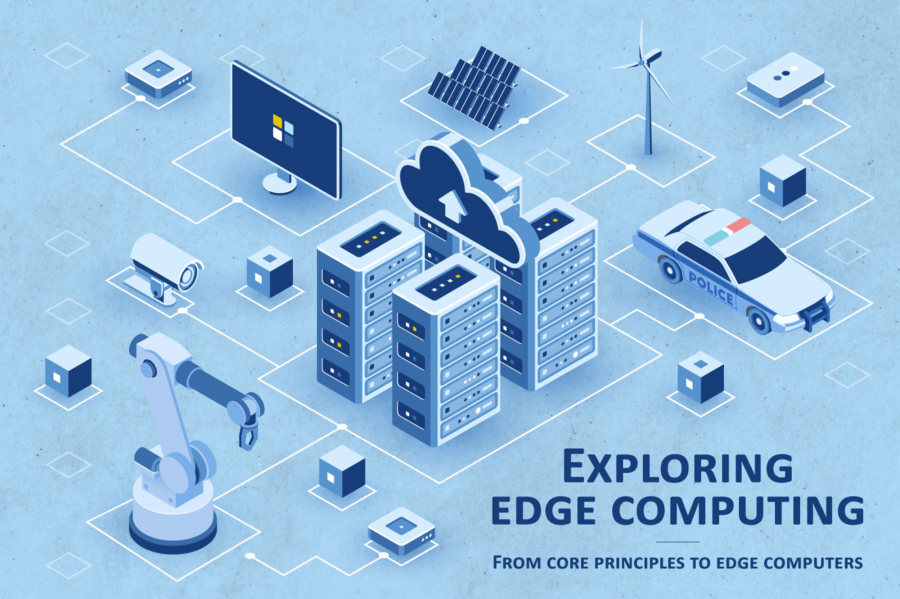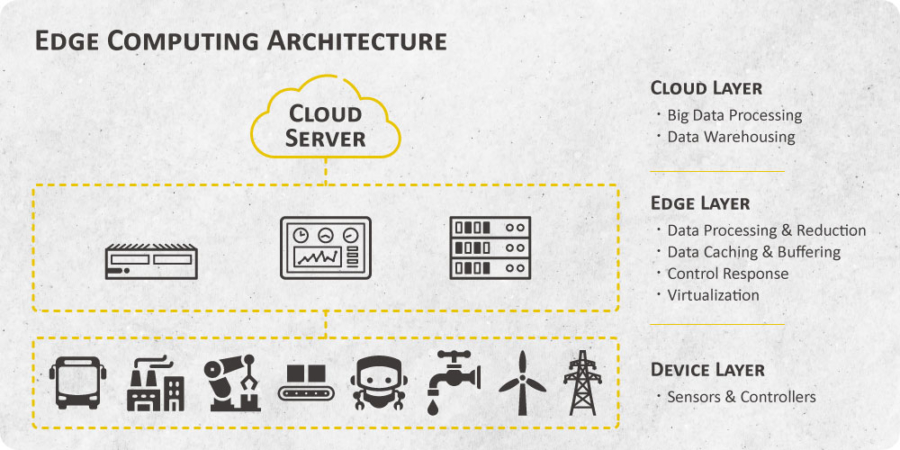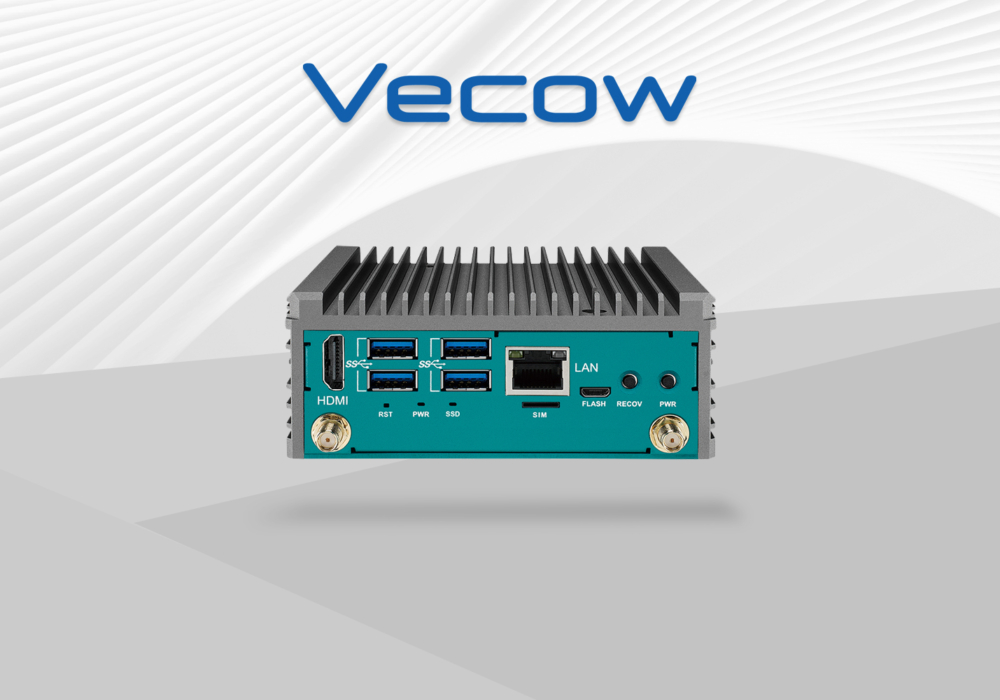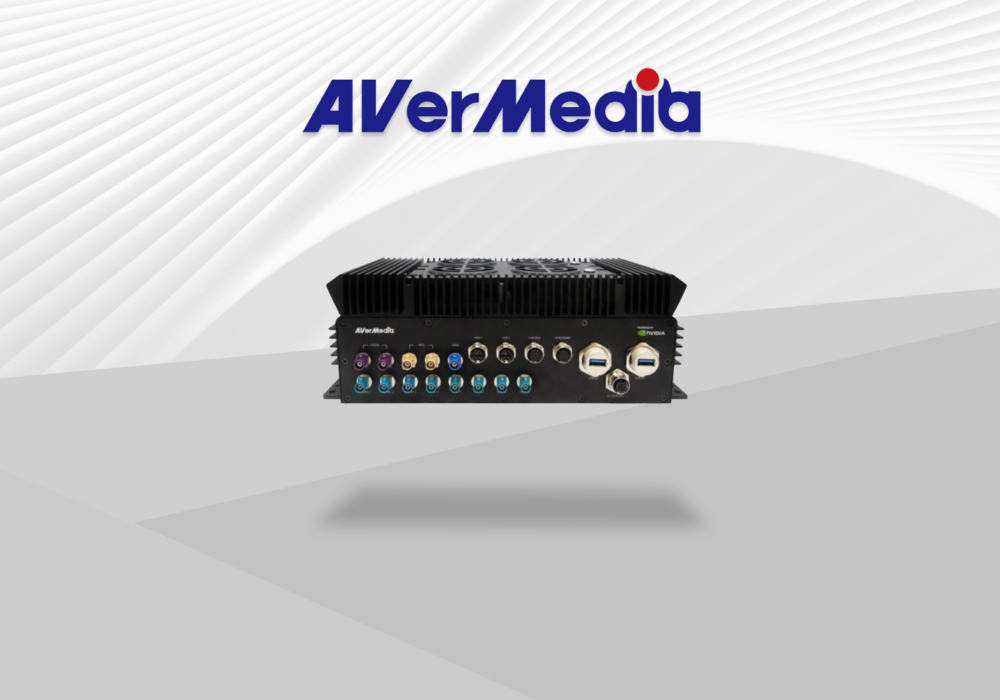In this article:
- Embracing Edge Computing For Future-Ready Solutions
- Edge Computing Architecture
- Unlocking Business Potential: Five Key Benefits of Edge Computing
- Empowering Your Edge Computing Experience: The Essential Features of Edge Computers
- Unlocking Efficiency: Edge Computing Applications in Manufacturing
- Key Benefits of Edge Computing in Manufacturing:
- Revolutionising Transportation: Edge Computing Applications
- Key Benefits of Edge Computing in Transportation:
- Energising the Future: Edge Computing Applications in Energy
- Key Benefits of Edge Computing in Energy:

Edge computing, the revolutionary distributed architecture, empowers lightning-fast and precise data analysis and processing directly at the source, ensuring immediate and swift responses. This stands in stark contrast to the outdated centralised computing approach, where data heavily relied on the cloud or central data centres. In our era of AI advancements and the widespread use of smart devices, the sheer scale and complexity of data have skyrocketed.
Industries like smart warehousing, vision-oriented manufacturing, and smart city traffic management face challenges where data transmission often surpasses network capacity. The continuous evolution of technology in industrial computers, cameras, mobile terminals, sensors, and diverse Internet of Things (IoT) devices accelerates data generation and collection. Relying solely on central data centres is no longer sufficient to meet these growing demands. Consequently, edge computing has evolved beyond a mere trend to become the optimal solution for real-time insights.
Key Features of Edge Computing:
- Swift Decision-Making: Edge computing facilitates immediate data analysis and response at the source, eliminating delays caused by centralised processing. This is critical for applications requiring rapid decision-making, such as smart warehousing operations and traffic management in smart cities.
- Data Transmission Efficiency: In sectors where data transmission needs often exceed network capacity, edge computing proves indispensable. By processing data at the edge, the system alleviates network strain, ensuring seamless operations in vision-oriented manufacturing processes and other data-intensive applications.
- Adaptability to IoT Growth: As industrial computers, cameras, mobile terminals, sensors, and various IoT devices advance technologically, edge computing seamlessly accommodates the accelerating speed of data generation and collection. This adaptability is crucial for staying ahead in the ever-evolving technological landscape.
- Real-Time Insights: With the rise of AI technology, edge computing delivers real-time insights, enhancing the efficiency of smart warehousing, manufacturing processes, and other applications. This immediacy is vital for staying competitive in today’s fast-paced business environment.
Embracing Edge Computing For Future-Ready Solutions
Edge computing is not merely a passing trend but a transformative solution that addresses the challenges posed by the escalating scale and complexity of data. Industries that harness the power of edge computing for smart warehousing, vision-oriented manufacturing, and smart city applications gain a competitive edge by ensuring immediate responses and optimal efficiency. As data continues to grow in volume and intricacy, embracing edge computing is not just a choice; it’s the best strategic move towards a future-ready and technologically advanced infrastructure. Stay ahead, make real-time decisions, and unlock the true potential of your operations with the unparalleled capabilities of edge computing.

Edge Computing Architecture
Optimised Edge Computing Architecture: Enhancing Efficiency Across Three Vital Layers
Unlock the power of edge computing with a comprehensive architecture strategically divided into three layers: the Device Layer for efficient data collection, the Edge Layer for real-time processing, and the Cloud Layer for secure storage and in-depth analysis.
Device Layer: Revolutionising Data Collection with IoT Devices
At the forefront, the Device Layer encompasses a diverse array of IoT devices, each equipped with built-in sensors dedicated to data collection and monitoring. Picture medical instruments in hospitals diligently tracking patients’ vital signs or autonomous vehicles dynamically gathering data on road conditions and vehicle dynamics. The Device Layer serves as the essential foundation for seamless data acquisition.
Edge Layer: Real-Time Processing Redefined
Situated closest to the source of data generation, the Edge Layer serves as the core of edge computing. Distinguished by its broader distribution compared to traditional cloud servers, this layer excels in real-time data processing and analysis, resulting in significantly reduced latency. When swift decision-making is paramount, the Edge Layer proves its mettle. In instances where data necessitates deeper analysis, a seamless transition to the Cloud Layer is orchestrated for further processing.
Cloud Layer: Synergising Edge and Cloud Computing for Comprehensive Analysis
While cloud computing has historically grappled with bottlenecks and latency, the Cloud Layer in a complete edge computing architecture complements and enhances the efficiency of both systems. The Edge and Cloud Layers work in tandem, seamlessly transferring data when deeper analysis is warranted. This strategic collaboration ensures a harmonious blend of real-time processing at the edge and detailed computation and storage capabilities in the cloud.
Unlocking Business Potential: Five Key Benefits of Edge Computing
Explore the transformative advantages of edge computing, propelling your business into a new era of efficiency, security, and innovation.
- Rapid Response and Improved Efficiency: In industries driven by automation, such as factory production lines, the need for real-time data transmission and processing is paramount. Edge computing ensures swift monitoring and corrective actions in the face of machine anomalies, substantially reducing production downtime and mitigating potential risks. Stay ahead with unparalleled efficiency.
- Enhanced Data Security: Elevate your data security standards with edge computing. By processing and storing most data on-site and encrypting essential information before transmission to central data centres, edge computing provides an extra layer of protection. Safeguard your critical data and foster trust among your stakeholders.
- Leap in Productivity: Edge computing propels enterprises towards heightened operational efficiency through real-time data feedback. Combined with the prowess of artificial intelligence and machine learning, it conducts in-depth analyses of business data, facilitating swift decision-making and identifying areas for improvement. Experience a leap in productivity like never before.
- Remote Data Collection: Overcome challenges in remote data collection, typical in areas with unstable network connections or limited bandwidth, such as offshore oil fields or vessels. Edge computing brings computing and storage capabilities directly to these locations, ensuring seamless data collection and transmission. Unleash the potential of remote operations without compromise.
- Cost Optimisation: Edge computing introduces a cost-effective paradigm shift. While transmitting large amounts of data traditionally incurs substantial bandwidth costs and setup expenses, the edge computing architecture allows selective transmission of essential core data. This strategic approach reduces overall setup expenses, offering a pathway to cost optimisation without sacrificing functionality.
Empowering Your Edge Computing Experience: The Essential Features of Edge Computers
Explore the heart of the edge layer – the robust and versatile edge computer. As the pivotal system component responsible for processing and analysing data collected from the device layer, edge computers demand specific features to ensure optimal performance and adaptability.
- High Durability for Challenging Environments: Operating in ever-changing and harsh environments near the device layer, edge computers require superior durability. A fanless design guarantees stability even in polluted, dusty, or humid conditions. Shock resistance and vibration tolerance are crucial, especially in high-vibration environments, ensuring reliable performance when it matters most.
- Outstanding Performance for Complex Data Analysis: With the increasing complexity of data analysis challenges, performance is a critical factor for edge computers. Especially with the rapid evolution of AI technology, edge AI computers have emerged. Supporting multi-core CPUs and GPUs specifically designed for real-time image processing, they efficiently analyise and store data from the device layer.
- Rich I/O, Connectivity, and Storage Options: Seamless connectivity with various devices is a prerequisite for edge computers. Having a diverse range of commonly used I/O interfaces, including WiFi, 4G, 5G, GNSS, Bluetooth, and wired transmission, helps to ensure connectivity in different field scenarios. Additionally, edge computers can be found to support options for large-capacity or high-speed storage to accommodate the vast amount of data collected from the device layer.
- Industrial-Grade Protections for Remote Deployments: As they are deployed in remote or harsh environments, edge computers must feature industrial-grade protection. Wide voltage support, ESD protection, surge protection, and EMC protection ensure efficient and stable operation under various conditions. These protective features are essential for maintaining reliability in challenging deployment scenarios.
- Flexible Installation Options for Diverse Applications: Recognising the varied deployment environments of edge computers, flexibility in installation options is paramount. Whether wall mounting, VESA mounting, DIN rail mounting, or panel mounting, these options provide users with multiple choices to meet the diverse needs of different applications. Adaptability is key to seamless integration into various spaces.
Unlocking Efficiency: Edge Computing Applications in Manufacturing
Discover the transformative applications of edge computing in the manufacturing sector, redefining processes and optimising operations.
- X-ray Inspection for Precision Quality Assurance: In manufacturing, X-ray inspection emerges as a non-destructive, high-precision, and efficient solution for quality assurance. This cutting-edge technology plays a pivotal role in industries such as automotive, aerospace, and electronics, ensuring meticulous quality control and compliance.
- Automated Produce Sorting for Enhanced Efficiency: Edge computing revolutionises the manufacturing landscape by automating produce sorting processes. This replaces manual judgment, leading to a significant reduction in error rates and a remarkable acceleration of work efficiency. Streamline your operations and ensure consistent quality with automated sorting solutions.
- Smart Spinning Systems for Intelligent Manufacturing: Embrace the era of intelligent manufacturing with smart spinning systems powered by edge computing. These automated systems seamlessly integrate sensor technology and edge data collection capabilities. The result is intelligent monitoring, precise energy management, and predictive maintenance, all orchestrated through a centralised cloud control centre. Elevate your spinning operations with the efficiency of edge computing.
Key Benefits of Edge Computing in Manufacturing:
- Enhanced Quality Control: X-ray inspection and automated sorting ensures meticulous quality control, minimising defects and errors in the manufacturing process.
- Accelerated Efficiency: Automated processes driven by edge computing significantly reduce error rates, leading to accelerated work efficiency and increased productivity.
- Intelligent Monitoring and Predictive Maintenance: Smart spinning systems leverage edge data collection for intelligent monitoring, energy management, and predictive maintenance, ensuring optimal performance and longevity.
- Cost Optimisation: By automating manual processes and minimising errors, edge computing in manufacturing contributes to cost optimisation, improving overall operational efficiency.
Revolutionising Transportation: Edge Computing Applications
Explore the impactful applications of edge computing in the transportation sector, transforming safety, productivity, and efficiency.
- Automated Track Inspection Vehicles for Enhanced Rail Safety: Elevate rail safety with the deployment of automated track inspection vehicles leveraging edge computing. Regular inspections and real-time monitoring become imperative for ensuring the safety of train operations. Edge computing ensures swift data analysis, enabling proactive measures to maintain track integrity and prevent potential hazards.
- Unmanned Mining Vehicles for Hazardous Environments: In the challenging and hazardous mining industry, intelligent autonomous driving mining vehicles become a game-changer. Operating 24/7, these vehicles, empowered by edge computing, significantly improve productivity and safety. Real-time data processing enhances navigation and decision-making in harsh mining conditions, ensuring optimal operations.
- Smart Police Cars for Advanced Safety in Smart Cities: Transform law enforcement in smart cities with the integration of smart police cars powered by edge computing. Connecting to city data centers, these vehicles provide precise support for traffic management and emergency response. License plate recognition, facilitated by edge computing, enables rapid detection of problematic or stolen vehicles, contributing to the prevention of criminal activities and enhancing overall safety.
Key Benefits of Edge Computing in Transportation:
- Proactive Rail Safety Measures: Automated track inspection vehicles equipped with edge computing enable proactive measures to maintain rail safety, ensuring uninterrupted train operations.
- Continuous Mining Operations with Enhanced Safety: Unmanned mining vehicles, backed by edge computing, operate seamlessly in hazardous environments, improving productivity and ensuring the safety of mining operations.
- Precision in Law Enforcement: Smart police cars, connected to edge computing, provide law enforcement in smart cities with precise tools for traffic management and emergency response. License plate recognition enhances quick detection, contributing to crime prevention.
- Efficient Emergency Response: Edge computing facilitates quick data analysis and communication, enabling smart police cars to respond efficiently to emergencies, enhancing overall safety in smart city environments.
Energising the Future: Edge Computing Applications in Energy
Uncover the dynamic applications of edge computing in the energy sector, redefining efficiency, monitoring, and security.
- Offshore Automated Oil Rigs for Real-Time Operations: Offshore and remote oil and gas extraction operations demand precision and efficiency. Edge computing transforms offshore automated oil rigs by enabling real-time data monitoring and remote management. This critical application ensures seamless operations, minimising downtime, and enhancing overall efficiency in the challenging offshore environment.
- IoE Gateway for Enhanced Energy Efficiency: The integration of energy and the internet takes a giant leap forward with IoE Gateway powered by edge computing. This innovative solution combines renewable energy nodes with the power grid, optimising energy efficiency and management. Through meticulous data analysis, it not only collects information from various distributed sources but also precisely adjusts power distribution, ushering in a new era of sustainable energy practices.
- Oilfield Surveillance System for Enhanced Security: Safeguard remote oil fields with an advanced oilfield surveillance system driven by edge computing. In environments susceptible to theft or deliberate equipment damage, this system becomes a crucial preventive measure. By providing real-time monitoring and analytics, edge computing ensures prompt response to potential threats, maintaining the integrity and security of oilfield operations.
Key Benefits of Edge Computing in Energy:
- Real-Time Monitoring for Offshore Operations: Edge computing empowers offshore automated oil rigs with real-time data monitoring and remote management, reducing downtime and enhancing operational efficiency.
- Optimized Energy Efficiency through IoE Gateway: IoE Gateway, fueled by edge computing, integrates renewable energy nodes with the power grid, optimising energy efficiency through precise data analysis and distribution adjustments.
- Preventive Security Measures with Surveillance Systems: Edge computing reinforces security in remote oil fields with oilfield surveillance systems. By providing real-time monitoring and analytics, potential threats like theft or equipment damage are promptly identified, ensuring preventive actions are taken.
- Efficient Resource Utilisation: Edge computing ensures the efficient utilisation of energy resources by collecting and analysing data from various distributed sources, allowing for precise adjustments in power distribution for enhanced energy management.










